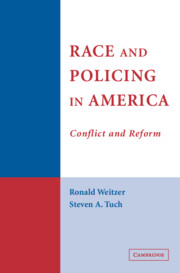5 - Conclusion: The Continuing Racial Divide
Published online by Cambridge University Press: 18 December 2009
Summary
In the middle of the last century the Swedish economist Gunnar Myrdal, in his monumental book An American Dilemma, was one of the first scholars to analyze the role of police in oppressing blacks in a society in which racial prejudice and discrimination were deeply entrenched in all institutions. Police in the American South, in particular, were pillars in a system of white supremacy and virtually unrestrained in their coercive treatment of blacks (Myrdal 1944:535–545). But Myrdal's work was an exception; police-minority relations did not become a topic of serious investigation until the late 1960s.
Much of what was written in the 1960s and early 1970s painted African Americans and the police literally in black and white, as little more than enemies locked in conflict. The social commentator James Baldwin used dramatic language, describing the typical police officer as one who “moves through Harlem like an occupying soldier in a bitterly hostile country, which is precisely what and where he is.” As for blacks' views at the time, police were hardly the friendly bobby on the beat: “Their very presence is an insult, and it would be even if they spent their entire day feeding gumdrops to children” (Baldwin 1962:67, 65). Baldwin's observations were confirmed by two blue-ribbon commissions. The President's Commission on Law Enforcement (1967:167) described white cops as an “army of occupation” despised in black neighborhoods, and the Kerner Commission (1968:206) concluded that, for many blacks, “police have come to symbolize white power, white racism, and white repression.
- Type
- Chapter
- Information
- Race and Policing in AmericaConflict and Reform, pp. 178 - 190Publisher: Cambridge University PressPrint publication year: 2006



